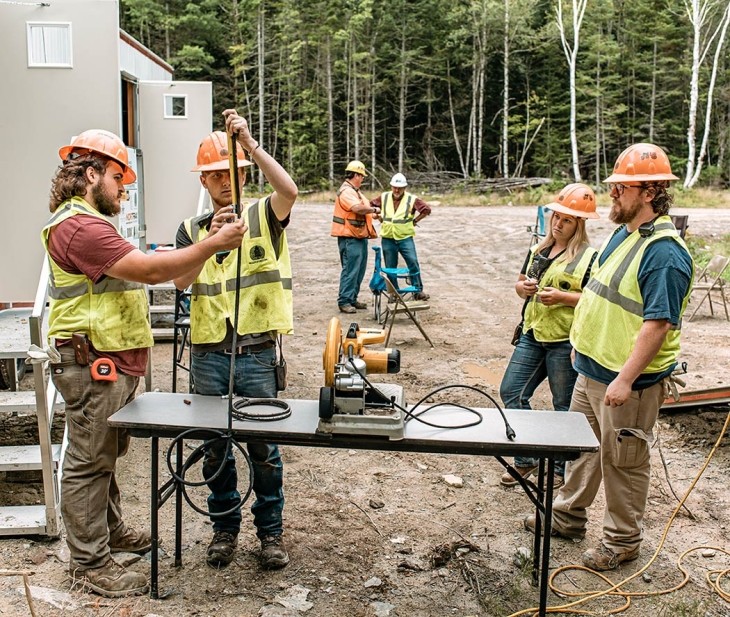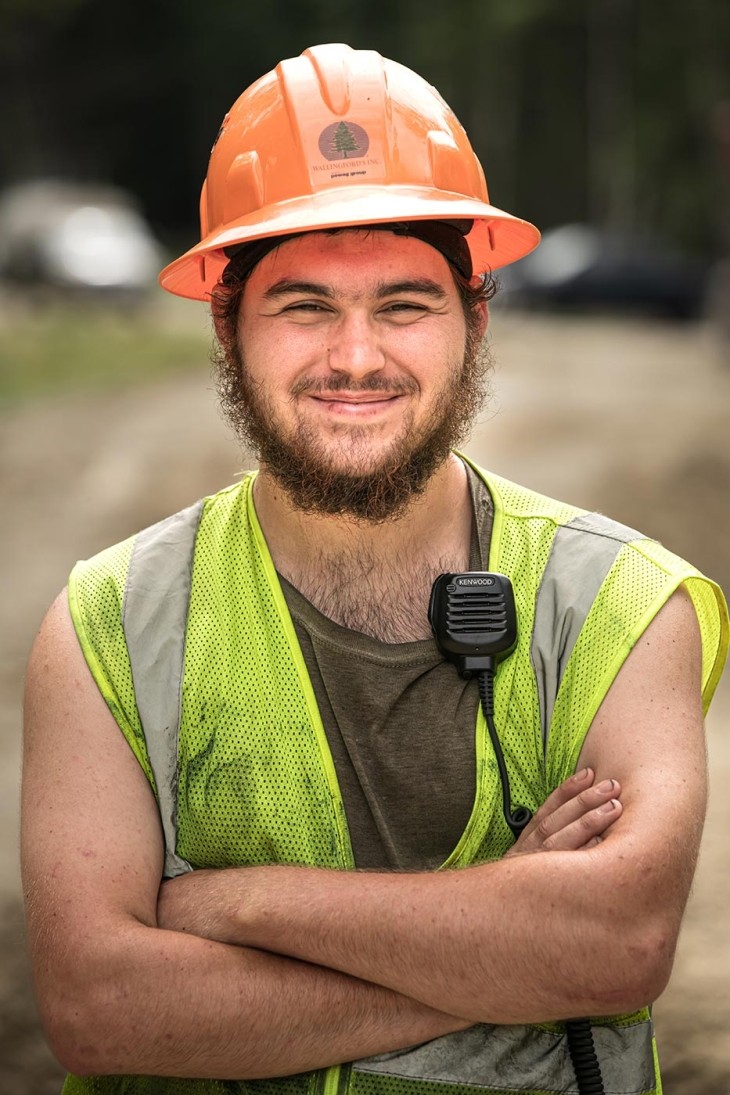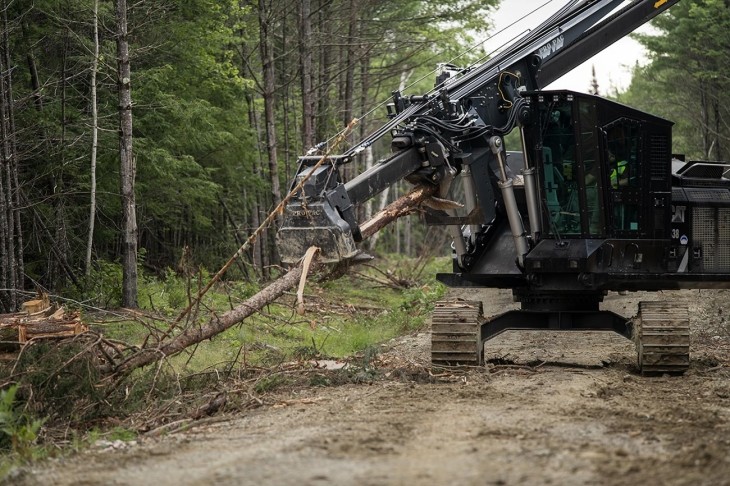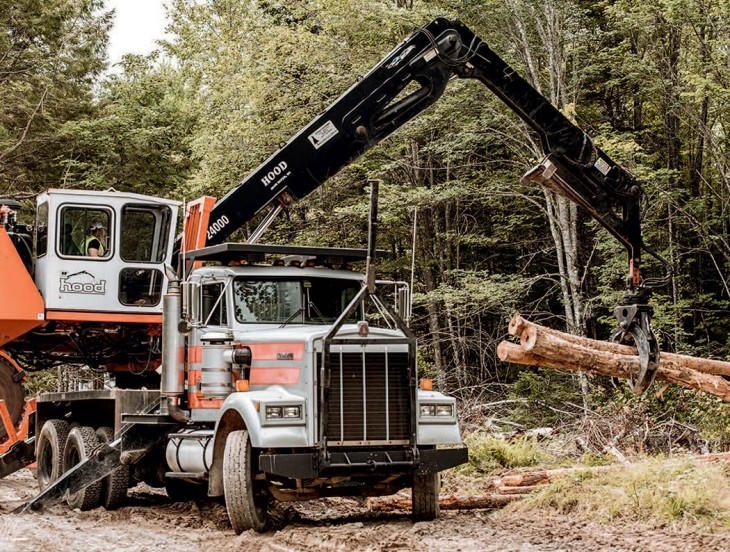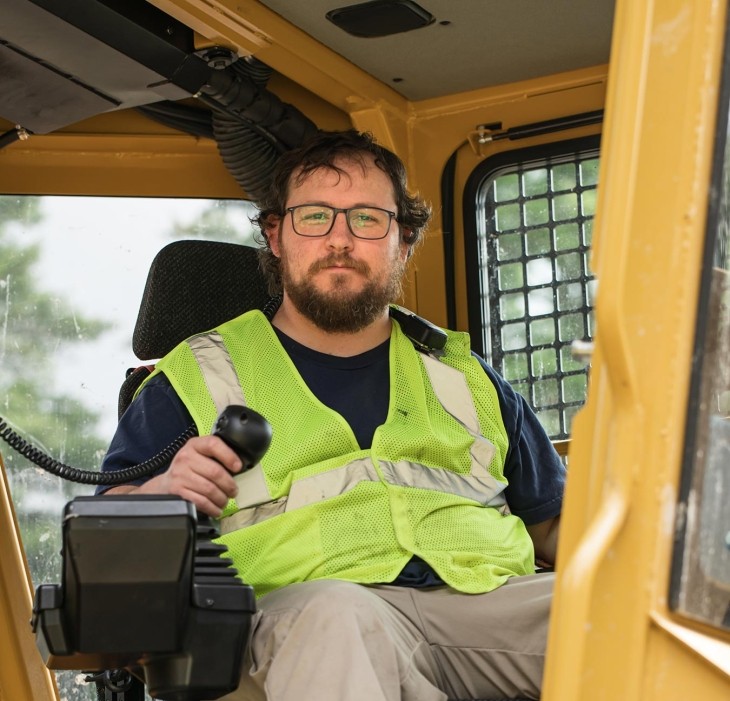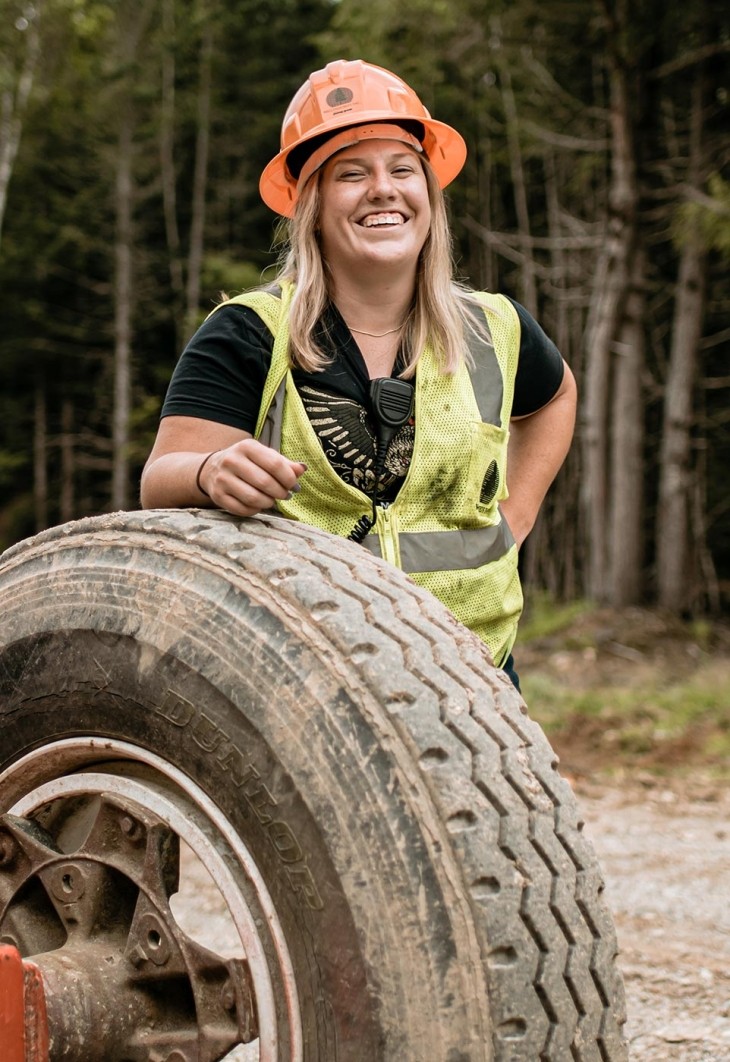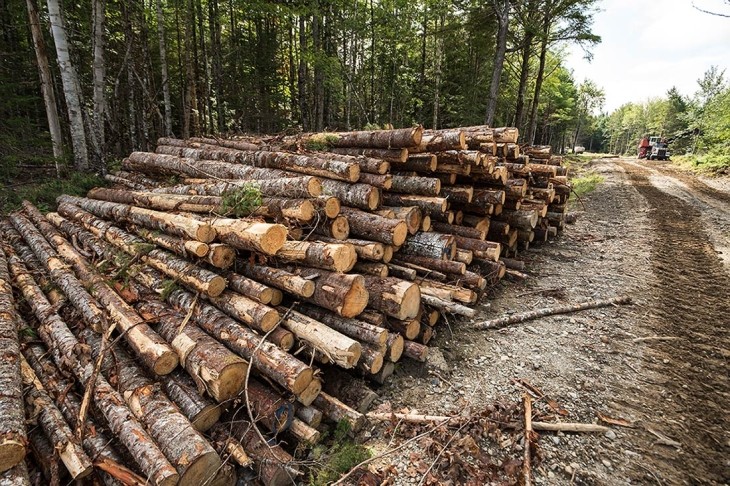An Innovative Program Prepares a New Generation of Loggers
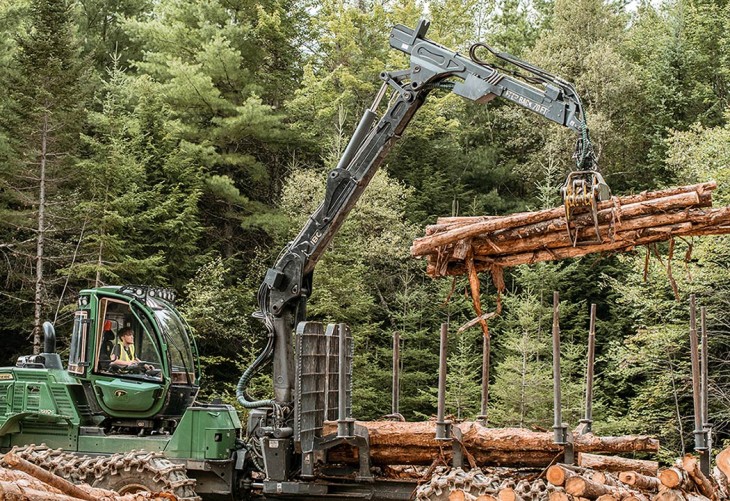
It has been raining all summer in northern Maine, the 10th wettest summer on record, and this Wednesday in August dawns overcast, the low gray clouds plump and threatening to overspill at any moment. It’s humid on the ground, too. The morning dew point and the temperature are twinning, both in the mid-60s, saturating the air. It’s one of those days when a sensible person just wants to hunker down.
Not so with the half-dozen morning-shift students of the Mechanized Logging Operations and Forest Trucking (MLOFT) Program who’ve been on the job since 5:00 a.m., deep in the buggy woods of Summit Township, northeast of Old Town. They like the feel of weather, the changing elements, the turning of seasons – in fact, for some, that’s the whole point.
“I came here because I wanted to be outside,” says Dylan Hooper, who rises at 3:00 a.m. each day to make the two-hour drive from his parents’ home in Blue Hill to the open-air classroom. No matter the weather, he adds, “I just want to be in the woods.”
Lauren Robinson agrees wholeheartedly. “I don’t want to be sitting in an office all day long, dealing with some people that I don’t like and having to do paperwork,” she says. “I love to be outside. That’s just my number one key thing.”
A Professional Pathway
On this day Hooper, Robinson, and their classmates are marking the halfway point of the post-secondary program to train the next generation of Maine’s loggers. Created seven years ago by three community colleges and the Professional Logging Contractors of the Northeast (PLC), it attracts applicants from all over Maine with an impressive value proposition: enroll in an intensive high-tech program that combines classroom learning with on-the-job, behind-the-joystick training; maintain an exhausting 12-hour weekday schedule for 20 weeks; and come out with a Commercial Driver’s License (CDL) permit and all the work experience you’d need to operate machinery with hyphenated names such as grapple-skidder, feller-buncher, stroke-delimber, and crane-slasher.
And it’s free.
Actually, it’s better than free, contends PLC Executive Director Dana Doran, who helped launch the program. Not only do foundation and government grants cover the entire cost of tuition, but they also provide all the personal protective equipment the 16 students will need – and a $1,000 cash stipend to each student for transportation and housing.
Surveying the line of advanced equipment that runs a quarter-mile up the gravel forest road, each with a professional instructor overseeing the work of individual students, Doran admits that the training program “is not a cheap one to run.” Beyond the waived tuition and the stipends, there’s also the expense of instruction, administrative overhead, and at least $2.5 million in new, state-of-the-art machinery, fuel trucks, portable classrooms, and power tools on the site. The program couldn’t afford to acquire and maintain that equipment, Doran says, but dealers such as Milton Cat and United Construction and Forestry have stepped up to the plate.
Such generosity is not without self-interest.
“The fact is that if you get trained on a John Deere, you’re going to want to work on a Deere,” Doran observes. “And today, 95 percent of all logging is done with this equipment. It’s almost entirely mechanized. Only 5 percent, at most, is done by chainsaw.”
But it all begs the question: Given the expense, how can a program graduating just 12 to 15 students annually make economic sense?
By his wry smile it’s clear Doran is ready for this one. He’s probably answered the question a hundred times – to visiting state legislators, to the PLC board of directors, and to the executives of those foundations and businesses that support the program.
Put simply, he says, it’s just too expensive for the industry to go forward without a professional pathway for training, just like any other trade that exists. “Back in 2015 our membership was struggling to find qualified employees,” he says. “And while it’s probably more today, back then it cost them about $100,000 in the first year to hire a new employee with no prior logging experience.”
Recruitment costs, training time, salaries, benefits, and most frequently, the loss of production due to operational errors and broken equipment, had turned the hiring process into a high stakes gamble that was producing more losers than winners.
“In our industry, it had become an unsustainable commitment to hire a new employee with no experience,” Doran says. “No new employees, no more logging.” No more logging, and a loss of the engine that makes the forest industry possible, and with it, regional wood production and almost all forms of forest management.
A Heritage Industry Under Threat
Not far down the Penobscot River from the job site where Hooper is sitting in the cab of a $700,000 forwarder, there’s a 31-foot statue of Paul Bunyan shouldering a double-sided ax with one arm while leaning on a peavey with the other. Halfway between those points, in the town of Bradley, is Maine Forest and Logging Museum, which houses a 19th-century water-powered sawmill and a collection of steam-powered Lombard log-haulers from the earliest years of the 20th century.
Here, geography provides a metaphor for a continuous line of history – unbroken, perhaps, but under constant threat.
“Logging has been a part of Maine’s economy since the 1600s and is the base for the entire forest products industry,” says State Economist Amanda Rector. Today, that includes “logging and forestry, paper and related production manufacturing, sawmills and wood-product manufacturing, wood furniture manufacturing, and the generation of biomass electricity.”
According to 2019 data from the PLC, the forest products industry contributes an estimated $8.1 billion in annual output, more than 31,000 jobs, and $1.7 billion in payroll to the state’s economy. Of that, logging and trucking supports nearly 5,600 direct and indirect jobs with a $312 million payroll, generating $582 million in economic output.
Beyond its outsized impact on the economy, logging and forestry loom large in the state’s self-image. “Heritage industries are those economic sectors that not only have a long history in a place but are also intrinsically tied to the identity and culture of that area,” Rector explains. Typically tied to natural resources, these industries not only produce calculable economic benefits to the state, but intangible benefits as well. But, she adds, “It is also extremely difficult, if not impossible, to quantify the value derived from being a heritage industry.”
Given its central economic and cultural position, it’s hard to imagine logging facing an existential threat in Maine. But according to Doran, it’s equally difficult to recall a time during the past 50 years when logging’s future wasn’t zigzagging between major shocks to the system and rebounding prosperity, fueled by technological innovation.
Prior to the 1970s, mechanization played a relatively small role in harvesting and transport. At that point, Doran says, 9 out of every 10 trees in Maine were cut with chainsaws, using cable-skidders to get logs to rivers where they were floated to mills each spring. But that all changed in response to the Clean Water Act, sponsored by Maine’s own U.S. Senator Edmund Muskie and passed by Congress in 1972.
“That really shut down movement of wood by water, and that in turn created the need for roads, road infrastructure, and trucks,” Doran explains. “As a result, we began to see more mechanization of the industry.”
That was soon followed by the spruce budworm epidemic, which prompted the state’s large land-holders to resort to clearcutting in order to utilize the wood before it went to rot.
Not surprisingly, that practice generated its own reaction in the form of statewide referenda that sought to prohibit clearcutting and prompted the passage of the Forest Practices Act, which as Doran says, imposed “strict guidelines on how the forest resource was managed, how much could be taken out in any given harvest under specific conditions.”
Over the past 20 years, changing patterns of land ownership and paper mill closures have also impacted logging, reducing annual harvests from 20 million tons in Maine to about 12 million tons today.
The net result, according to both Doran and Rector, is that logging contractors increasingly turned to technology and mechanization to adapt to the economic, political, and environmental changes they experienced. The expense and investment required, and the bottom-line risk of mechanical failures, have fundamentally changed the ability of small family operators to thrive and for new loggers to establish their own businesses.
Today, there are only 412 logging operations left in the state, down from more than 450 just five years ago.
Randy Kimball, 39, of Poland, has seen that change firsthand. His father Ronnie started Kimball and Sons Logging and Trucking with a skidder and a chainsaw. Over the years, he gradually acquired trucks and machinery – assets with cash value beyond the company’s book of business.
“Thanks to him, I had a head start,” Randy says. “But starting fresh today, it’s got to be a million dollars or more investment. You can’t start small."
Kimball then starts ticking off the challenges. “It’s the expense, the overhead, the thin margins,” he says. “Then there’s high, high stress, payroll, breakdowns, equipment payments. It don’t end. It never ends.”
“Today, logging is not for the faint of heart,” Doran agrees. “You only get paid when the wood crosses the scale, and any disruption can break a business. There are millions of dollars’ worth of equipment wrapped up in this, and you can’t afford any downtime.”
Organized Chaos
Instructor Phil Smith, a veteran operator who lives in nearby Greenbush, is giving directions to 18-year-old Lucas Gustin of Corinth. It’s Gustin’s first day in the grapple-skidder.
“Make your turn,” Smith advises. “Now get your wood up off the ground…There you go!”
Gustin maneuvers the 50,000-pound machine from the edge of the woods and sidles up next to the delimber. Close, but not too close. “Right there!” Smith says into the radio. “Now drop it.”
At this point, success is just following the instructor’s directions. By the end of the rotation, Gustin will be able to operate the machinery on his own, making decisions about which trees to harvest and how to sort them for collection by the roadside based on the species, size, and likely end use.
A little distance away, program director and lead instructor Donald Burr watches with satisfaction. Some days on the job site – which constitutes half the curriculum – everything goes smoothly. Other times, he says, it’s “just organized chaos.”
“In theory we have one piece of equipment per student,” he explains. “What they do is spend a week – or five days in a row across two weeks – in the same piece. So Wednesday morning, there’ll be a student who rotates in to the grapple-skidder, and we’re going to go through every bit of it, talk about the different components and whatnot. Our mandate is to give the students the foundation of what they’ll need to know to safely operate this equipment.”
Burr downplays the technological hurdles contemporary mechanization present to newcomers. “We start very small, just moving joysticks back and forth and kind of feeling the machine and checking out all the buttons and trying to get their thumbs to do what needs to happen, what button does what, and that kind of stuff,” he says. But they pick it up quickly – many of the students were born just before the iPhone was introduced, and technology is second nature to them.
Burr also drills students daily in tree identification, safety, and mechanical maintenance and repair. “When they go to work, they’ll have all the tools,” Burr says. “They know to grease these points. They know that’s where the fuel filters are, and that’s where the hydraulic pump is. Here’s how the fire suppression system works. They know all that kind of stuff.”
Burr spends the morning moving from machine to machine. An operator for 22 years, he’s got a jocular, almost fatherly, relationship with the students, who razz him for his dreadful “dad jokes.” But among colleagues in the industry, Burr has earned a reputation for professionalism, an unwavering commitment to safety, and as it turns out, a knack for recruitment.
“It’s the perfect position for him,” Randy Kimball says. “Since he began, the program has grown. Classes are always full.”
Burr is a natural teacher. There are times that demand his natural, easygoing demeanor, when students feel frustrated or stymied in their efforts to complete a task. And there are times when he needs to be unambiguously clear about the need for safety and precision.
“We want to do it right. We’re teaching you to do it right,” he tells the students. “Sometimes we’ll need to make decisions about what’s best for the land, and it is not always easy to do the right thing. Remember, we’re not selling the wood. We’re selling our work, our professionalism, our expertise.”
Later in the day, as the students take their lunch break, Burr adds, “My product isn’t the wood the class harvests while we’re on site. My product is them – the students. My purpose is to create a quality employee from each student.”
Some Bleed Sawdust
At lunch, Gustin admits he was a little worried about the first day in the grapple-skidder, “given the struggles the last two guys before me had.” A fast learner, he’s already looking ahead to the next step in his rotation: the crane.
Unfortunately for the logging industry, Gustin says he may not be headed into the woods. He has a job opportunity lined up as a diesel mechanic with an equipment dealer in Bangor but needed to get his CDL. When Burr visited his high school to talk about the program, Gustin saw an opportunity.
“This might be a good way to get ahead,” he told himself, and applied.
Like Gustin, Dominick Olsen was attracted by the opportunity to get the CDL training. At 34, he’s the oldest of the morning group of students, and says he’s returned to school to earn a better living for his wife and son. “That’s the main reason I’m here,” he says. “I drove a box truck before. But this experience, it’s a pathway to buying a home.”
The CDL component is new this year, and while it serves as a useful recruiting tool (nearly a quarter of applicants to logging companies are truckers by occupation), it also reflects one of the industry’s current pain points. Just over 50 percent of logging companies truck all or most of their wood, and they find themselves competing with other industries to attract and retain professional drivers.
As Kimball notes, hiring employees who can do it all – from tree selection to mill delivery – helps companies create a reliable year-round workforce. But it also means other industries are constantly poaching drivers, too.
“The logging side is completely different for me, and there’s a whole lot more information to take in,” Olsen says, as if he’s already re-evaluating his career plan. “This is just my second machine, so…I’m old enough to know not to be too set in my ways.”
Then there are others who – as Doran puts it – just bleed sawdust.
During lunch, 18-year-old Adam Meng, a recent graduate from Mount Blue’s high school forestry program, makes it clear he’s one such character. “I've been interested in working in the woods my entire life,” says Meng, a longtime hunter and fisherman. “I’ve done a year of it already and absolutely loved it. I love just being out here. I love running the equipment.”
While he sees the CDL portion of the training as a bonus, he hopes to work as a logging operator in the woods around Farmington and the Kingfield area.
Like Meng, Lauren Robinson, from Guilford, also came to the program with some experience. Her father started taking her out on small logging jobs four years ago, and he taught her to run a forwarder. Those jobs confirmed her desire to pursue a career in the woods.
“Originally I was thinking about being a game warden, but I didn’t want to go to school for four years,” she says. A family friend connected her to Donald Burr, she applied to the program, “and it was off from there,” she adds. She started just two weeks after graduating high school.
“I was a bit timid, somewhat nervous, because I was the only girl,” she recalls of the first day in the classroom. “I walked in to this program, I had no idea who anyone was, and I’m like, oh, they know a lot more about everything than me. I mean, yeah, I know the forwarder. That’s simple to me. But they know way more mechanics. They know how to fix things…. I learned how to do hoses and stuff like that beforehand, but not fixing things on my own.”
There’s an irony here, because it’s clear that the young men in the class admire Robinson’s know-how. After a long morning in the equipment and a short lunch, Burr sends the afternoon cohort off to the machines and herds the morning team in to a hands-on hose fabrication class. He starts by sending each student to the nearby box truck for specific fittings, tools, and hoses, testing their knowledge. Most of the group are looking to Robinson for help identifying the parts they need. And it’s Robinson who fires up the generator and the chop saw to cut hose to length.
Despite her facility with the lesson, she’s eager to get back to the hands-on work of processing wood. “I’m most definitely here to run equipment,” Robinson says. “The processor and the skidder. Those are my two favorite pieces. Sitting around each afternoon when we have classroom time, it’s not overly fun, but it’s information that we need later on in life when we go and work in the woods on our own.”
The Future of Logging in Maine
Before day’s end, Doran has one last job. With the students standing and sitting in a semicircle around him, he hands out stipend checks. He makes a point to recognize each of the program’s financial supporters by name. He congratulates the students for their work so far and urges them to stick with it to the end.
“Take full advantage of this program,” he says. “And give back as much as you receive.”
Even as the rain begins to fall, the atmosphere is charged. The checks are small money – the stipend is doled out in thirds – but there’s something about getting paid to do something you love, in a place you love, that makes you feel lucky.
“My parents knew that I would go into this, and they just are really happy with what I’m doing right now,” Robinson says later, reflecting on the day. “Even though logging may not be able to make you a lot of money, it’s a lot better than being in the city, doing something you don’t like.”
From Doran’s perspective, Robinson is proof positive that the 7-year-old training program is working. In addition to creating a skilled workforce, he says it’s imperative that the industry diversifies and expands – a 2019 report from the University of Southern Maine predicts up to 2,000 positions in timber harvesting and trucking will be available in the next decade. Without attracting more women, minorities, and young people without a typical Maine woods background, those jobs will go unfilled.
And the industry is watching the program carefully, measuring its efficacy with benchmarks for placement rates, retention rates, and qualitative feedback from employers.
“At this point, 60 to 65 percent of the students who have gone through the program are still working in the industry,” Doran says, earning an average of $60,000 to $65,000 a year. “I’d say that’s the true measure of success. If we were training 14 per year and only 2 were getting hired and after three years, none of them were working in the industry, that’s a miserable failure, but that’s not the case.”
Even though she’s already received job offers both in and outside of logging, what excites Robinson the most are the long-term prospects made possible by the program: staying close to home and running her own operation.
“Maybe someday I’ll have my own company and do logging – do just small jobs like my dad did,” she says. “So I know it’s way out there, but you only swing for possibilities. That’s all you can do.”


